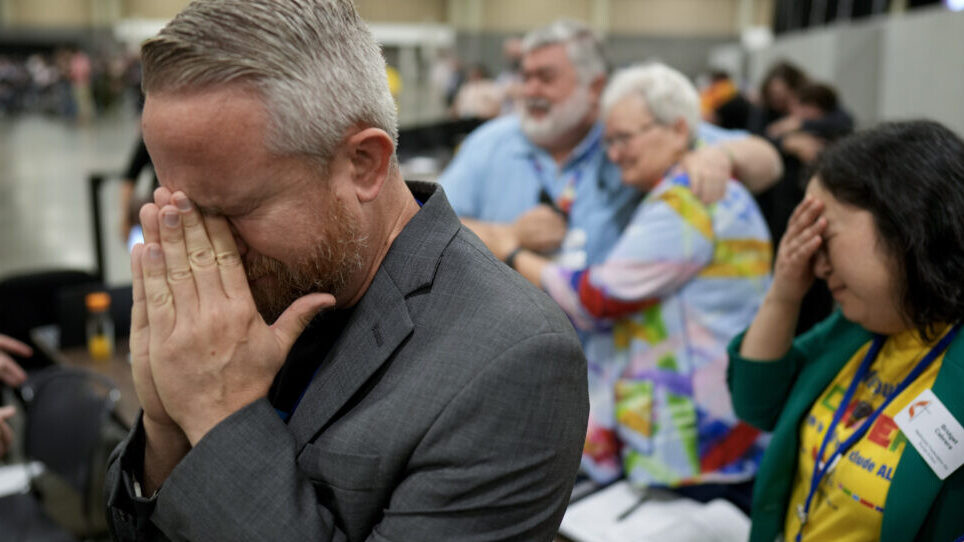In April of this year, the United Methodist Church (UMC) repealed a longstanding ban on same-sex relationships and marriages within thier United States delegation. The self-described “historic” conference saw four changes to the church law, which impacted specifically same-sex attracted clergy and congregation, while also the protecting the rights of the pastors to choose which weddings they will or will not perform.
Homosexuality as a point of discussion for the UMC has been apparent in the church since 1971, when a bizarre turn of events saw church leader Rev. Gene Leggett come out as homosexual… in order to defend the right of privacy for a fellow church elder.
Reverend Gene Leggett Defends Reverend Wil Schaefer
Reverend Wil Schaefer, a rather polarizing preacher, had an adulterous affair with Mrs. Judy Nash while he was married with a wife and children. As a result, they stripped Schaefer of his ministry and subjected him to a church trial. They found Schaefer guilty on the grounds of immorality, non-ministerial conduct, and disobedience to church law. In the aftermath of his trial, church elders from across the country met for an emergency meeting on April 17 in San Antonio, Texas.

Gene Leggett outside his former church in 1971 (Grey Villet/LIFE Magazine)
Rev. Gene Leggett was a member of this meeting, and in defense of the minister, Leggett stated that the courtesy extended to himself by the clergy over his homosexuality (by tacitly ignoring it) should also be extended to Schaefer.
“[I ask] my brothers to deal publicly with what they have known privately… most of the ministers and leaders of the church have known this about me for some five years. We have lived in an unspoken agreement of ‘you leave me alone and I’ll leave you alone.’”
Unfortunately for Leggett, many did not know. They immediately made a motion to prefer charges of immorality against Leggett. (The presiding Bishop Eugene Slater dismissed it.) However, they simply postponed the ‘Leggett case’ until the conference six weeks later, and the UMC would experience another event that caused a schism within the church.”
The First Schism
In 1939, the United Methodist Church had finally reunited after ninety-five years of estrangement. In 1845, the question on the morality of chattel slavery caused the church to split and led to a long period of legal wrangling over church property (which just goes to show that really, wealth and power was probably behind this schism as well.) Regardless, the reasoning for its start, the moral dilemma was reflected in the inclusion or acceptance of homosexual members of the clergy and congregation in 1971, and it eventually caused schisms within the church and its newer denominations.
RELATED LINK: United Methodist Conference Lifts Ban on LGBTQ+ Clergy
At the time of the conference, Rev. Gene Leggett had already been discovered to have had homosexual relationships outside of his marriage. (As an aside: his wife’s name was Fanny and I know admitting this makes me a child, but this amuses me.) He was a relatively respected elder after his divorce. But he only became widely known when he chose to reveal that he was gay.”
Later in the month, Leggett decided to double down by sending out a letter addressed to “Dear Relatives and Friends”:
“I am still the same Gene Leggett you have always known…I have felt free to discuss this side of my nature; and with some I have been fearful to do so; with most of you it hasn’t been necessary. We have continued to care for each other as we are.”
As positive as this sounds, he was under no illusion that the Church would be accepting:
“The Church is quite upset to have it in the open…” he said. “I do not know what action the Conference intends to take.”
1971 San Antonio Conference
Gene Leggett’s refusal to request a voluntary relocation was what stirred a protest from the “Gay Liberation Front” presenting a ten-point manifesto over the Church’s treatment of homosexuals at the 1971 conference. Gene Leggett himself had nothing to do with this, but the protest did not curry favor with the room for Leggett.
Despite the defense of Leggett by some prominent senior ministers, Leggett was subject to involuntary location, limiting his preaching and refusing his ordination as a pastor of the UMC.

The Rev. David Meredith, left, and the Rev. Austin Adkinson sing during a gathering of those in the LGBTQ community and their supporters outside the Charlotte Convention Center, in Charlotte, N.C. (Peter Smith/AP News)
The following year in 1972, due to the discussions on Leggett, the UMC passed a series of church laws, policy changes and confirmation of beliefs that saw homosexuals be specifically ostracized in church doctrine, however they were timid at best. “We do not recommend marriage between two persons of the same sex,” and “we do not condone the practice of homosexuality and consider the practice incompatible with Christian doctrine.”
Leggett himself continued to protest for his reinstatement. For years, he led a protest at annual ordination services where he knelt gagged and with a bandana over his eyes to symbolize being silenced. Although Leggett died having not been ordained again, he believed that he needed to be honest as living two lives was “neither healthy nor Christian.”
Leggett’s legacy however continued to be felt in the years after his initial involuntary relocation, every conference there would be some discussion on homosexuality. And many ministers were either defrocked for administering gay weddings (Jimmy Creech and Franklyn Schaefer (no relation to Wil Schaefer) after a 1996 ban on ministers officiating and hosting “homosexual unions.”)
The Backfire of the Traditional Plan
It was in 2019, in the passing of ‘The Traditional Plan’ by the Wesleyan Covenant Association (WCA) that the cracks which had started forming long ago gave way to the eventual departing of several conservative congregations within the UMC. Although the ‘Traditional Plan’ was a further nail in the coffin for homosexual recognition, it was wholeheartedly rejected by 76-percent of the US Annual conferences in the same year. The display of defiance from the majority of the congregations was the last straw for the conservative factions with the WCA and the new Global Methodist Church (GMC) splintering from the United Methodist Church.
RELATED LINK: SafeHome.Org’s LGBTQ+ Safety Report Ranks US States
With the splinters gone, a quarter of the UMC membership left, and these were the numbers that successfully held back any chance of repeal for bans against homosexuals. Now without them, supporters of repeal and the One Church Plan (a solution that allowed both progressive and conservatives to practice the way they wished) had the numbers. In 2024, the annual conference was able to pass four motions repealing all the previous bans but allowing ministerial discretion to refuse or allow weddings; a kind of insurance policy.
So now what? And why does it matter?
The UMC is in no way as prominent in the United States as it was during the last schism of 1845 due to pro-slavery southern Methodists wishing to continue the abhorrent practice of chattel slavery. However, it’s telling that repealing the bans against homosexuals required a break with conservatives.

Tears of joy at the United Methodist Conference of April 2024. (Chris Carlson/AP Photo)
The history of the Methodists is one of conflict and conflict resolution; a thesis and antithesis. And just like in 1939, I foresee eventually a synthesis will occur for the United Methodist Church, WCA and GMC. Marriage is a conservative institute at its core. It may take another ninety-five years but the UMC saw the writing on the wall and knew that it was only a matter of time before acceptance was prudent and optically important.
The streak of libertarianism within the UMC will still see some backlash against LGBTIQ+ participation within the UMC as its parishes will be the arbiters of acceptance. These challenges are in the future for the UMC. We can but hope they make the correct choice.
This schism occurring is still a good thing. Now it is clear that the UMC can start developing more progressive policies without the conservative membership.
Sources: The Conversation, Methodist History Volume LV, People Need Jesus, Spectrum News, Them.Us, United Methodist Church, WPLN News
Get real time update about this post category directly on your device, subscribe now.




